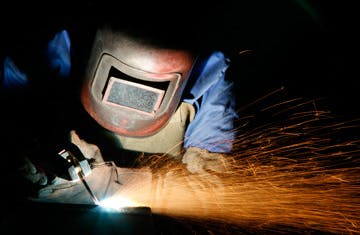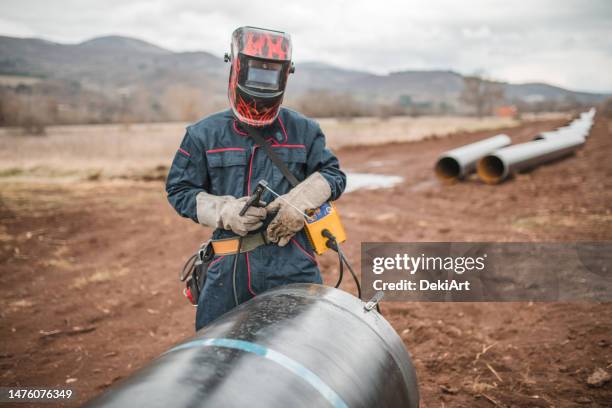Advanced Methods in Pipeline Welding Assessment: Developments and Technologies for Improved Precision and Integrity in Weld Assessment
The landscape of pipe welding evaluation is going through a considerable makeover, driven by advanced methods that promise to boost both precision and integrity in weld evaluations. Advancements such as automatic assessment systems and progressed imaging innovations are redefining conventional methods, while non-destructive screening approaches guarantee product honesty is maintained. As these modern technologies evolve, they not only raise problem discovery prices however likewise make it possible for extra efficient maintenance methods. However, the implications of these developments expand beyond prompt advantages, increasing critical questions regarding future methods and standards in the market.

Relevance of Weld Assessment
Guaranteeing the stability of pipeline welds is important to the overall safety and security and dependability of commercial systems. Rigorous assessment of welds is indispensable to the lifecycle of pipe framework.
The relevance of weld evaluation extends past mere conformity with regulatory criteria. It acts as an aggressive measure to determine and remedy imperfections, such as insufficient fusion, porosity, or fractures, prior to they rise right into significant issues. Reliable evaluation methods also add to the long life of pipelines, reducing upkeep costs and boosting operational performance.
Furthermore, comprehensive weld assessments foster trust among stakeholders, consisting of governing bodies, capitalists, and the communities served by these pipelines. By ensuring that all welds meet the needed requirements, organizations can alleviate dangers and promote their reputations. In recap, weld inspection is crucial not only for functional honesty however additionally for the broader implications it holds for security and ecological stewardship.
Automated Inspection Equipments
The combination of automated assessment systems in pipeline welding has actually transformed the technique to guaranteeing weld high quality and stability. These systems use sophisticated robotics and man-made knowledge to perform assessments that are not only faster yet also much more constant than traditional techniques. Automated systems can cover comprehensive lengths of pipes successfully, recording information that human examiners could overlook due to exhaustion or environmental problems.
Among the vital advantages of automatic inspection systems is their ability to operate in harmful settings, lowering the danger to human examiners. They utilize numerous non-destructive testing (NDT) methods, such as ultrasonic screening and magnetic particle examination, to assess weld honesty without endangering the framework. The information accumulated is refined in real-time, enabling instant feedback and prompt corrective activities when flaws are identified.
In addition, automated systems assist in the standardization of inspection processes, guaranteeing that each weld is evaluated against consistent criteria. This not just boosts the dependability of results however also improves compliance with regulatory standards. As markets remain to prioritize safety and functional performance, the duty of automatic assessment systems in pipeline welding will unquestionably broaden, leading the method for much more innovative high quality assurance methods.
Advanced Imaging Technologies
Often used in contemporary pipeline welding assessments, progressed imaging technologies have actually significantly improved the ability to discover and evaluate weld flaws. Methods such as electronic radiography, calculated tomography, and thermographic imaging read provide inspectors with high-resolution images that expose sub-surface flaws and structural inconsistencies that may be invisible to the nude eye.
This leads to quicker assessments and boosted accuracy in determining vital defects. Computed tomography, on the various other hand, provides three-dimensional imaging, allowing inspectors to imagine complicated geometries and examine the honesty of welds from several angles.
Thermographic imaging utilizes infrared innovation to find variations in temperature, identifying locations of potential weakness or stress and anxiety within the weld. These sophisticated imaging technologies not just boost issue detection rates however likewise minimize the time and resources needed for pipe inspections. Therefore, they play a vital function in preserving pipeline safety and dependability, making certain compliance with market criteria while lessening operational threats.
Non-Destructive Evaluating Methods
Making use of various strategies, non-destructive testing (NDT) approaches are necessary in pipeline welding inspections, allowing for the evaluation of weld integrity without jeopardizing the product's architectural honesty. NDT includes a variety of approaches, including ultrasonic screening (UT), radiographic screening (RT), magnetic bit testing (MT), and color penetrant testing (PT) Each method has distinct benefits and applications depending upon the details demands of the evaluation.
Ultrasonic screening uses high-frequency acoustic waves to spot internal flaws, providing specific measurements of weld density and stability. Pipeline Welding Inspection. Radiographic screening utilizes X-rays or gamma rays to produce pictures of the weld, exposing inner issues that may not show up externally. Magnetic fragment testing is reliable for discovering surface and near-surface discontinuities in ferromagnetic products, while color penetrant testing highlights surface splits by utilizing her comment is here a tinted color
Incorporating these NDT techniques into pipe welding evaluations improves the accuracy and reliability of weld evaluations, guaranteeing that possible failings are identified early. As markets require higher standards for security and performance, the role linked here of NDT in keeping the integrity of bonded frameworks continues to be essential in pipe building and maintenance.

Future Patterns in Weld Assessment
As we want to the future of weld evaluation, innovations in modern technology are poised to change the methods employed for assessing pipeline stability. The integration of expert system (AI) and artificial intelligence in examination procedures is expected to improve the accuracy of flaw detection and anticipating maintenance. These modern technologies permit real-time data evaluation, enabling examiners to identify potential problems before they intensify right into significant issues.
In addition, using drones equipped with advanced imaging systems is acquiring grip. These aerial assessments can cover large areas promptly, catching high-resolution images and information that can be examined for defects in hard-to-reach areas. This not just boosts security yet additionally increases effectiveness in the evaluation procedure.
Moreover, the advancement of smart sensing units installed in pipeline systems provides the potential for constant surveillance. These sensors can find adjustments in stress, temperature, and resonances, offering beneficial insights into the health of the welds gradually.

Final Thought
To conclude, the combination of sophisticated strategies in pipe welding assessment considerably boosts the accuracy and integrity of weld analyses. Innovations such as computerized assessment systems, advanced imaging modern technologies, and non-destructive testing techniques play an important duty in enhancing flaw discovery rates and cultivating proactive upkeep methods. As these innovations remain to advance, they will further make certain the safety and security and efficiency of pipe systems, inevitably adding to the honesty of important infrastructure.
